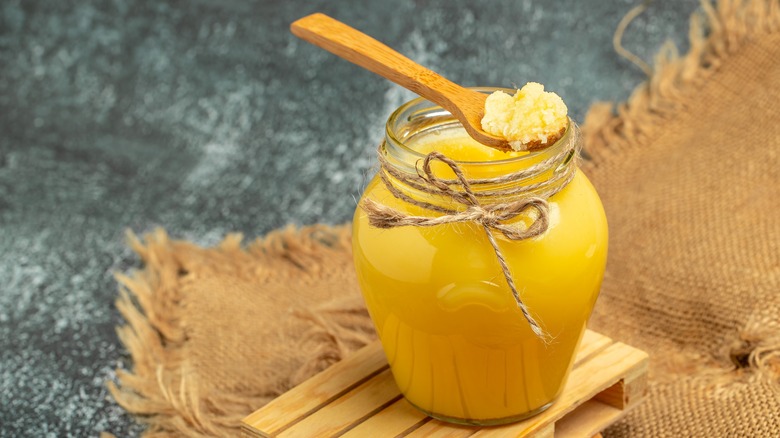Is Ghee Considered A Dairy-Free Ingredient?
Finding substitutions for ingredients can be challenging. If your pantry is bare and you don't fancy a trip to the grocery store, a quick internet search will usually put you right. However, if you deal with allergies or dietary restrictions, the substitution question can become more complicated and requires a deeper dive. When it comes to ghee and whether it can act as a dairy-free substitute for a lactose-intolerant or vegan diet, it's necessary to start at the beginning.
Often found in Indian and East Asian dishes, ghee is a type of clarified butter — but there is a difference between ghee and clarified butter, and it comes from the cooking process. For clarified butter, you simmer butter on a stovetop until it begins to foam and the milk solids fall to the bottom of the pan. When you strain the milk solids, the remaining liquid is clarified butter. Ghee, though, requires a little more cooking. The milk solids will fall to the bottom as they cook, but you don't stop there. Let the butter continue cooking until it turns a little brown and toasty — as if you were making browned butter. The liquid remaining after the milk solids are strained out is ghee.
Beginning here, the answer to the question of whether ghee is dairy-free or vegan: The short answer is no, it isn't. It's a type of butterfat. However, if you asked that question because of digestive issues, that's not the end of the story.
Taking a look at lactose and casein
Lactose intolerance typically comes from a person not having enough of the lactase enzyme in their small intestine, making them unable to digest the lactose in milk. When this happens, discomfort occurs after eating or drinking dairy — but not always. Ghee is one of those exceptions because despite still being dairy, it can generally be a good substitute and easier to digest for those who are lactose intolerant. Ghee's clarification process removes the milk solids, like lactose, and the fat that's left has very low lactose levels. Butter, in general, doesn't start with high lactose levels, but ghee can still be easier to tolerate.
The same applies if you have a casein sensitivity. Casein, a type of protein found in cow's milk, also has extremely low levels in ghee because of the clarification process, making it easier to digest for those with an intolerance. However, this only applies to sensitivities to these components; if you are allergic to casein or lactose, ghee should still absolutely be avoided for safety.
Substituting ghee for butter
Although ghee is handy for those who have difficulty digesting dairy, that is far from its only use, and generally speaking, it can be used anywhere you use butter and in much the same way. Ghee is popular because of its nutty, toasty flavor and because it can withstand higher temperatures than butter before it starts to smoke and become bitter (i.e., it has a higher smoke point). This high smoke point makes ghee the solution to cooking fried eggs without sticking to the pan because you won't have to worry about the butter burning if the temperature gets a little too high. A higher heat tolerance is why ghee should also be used to cook a pancake breakfast — plus, you'll get the added benefit of the toasty flavor.
One other benefit ghee has over butter is that its shelf life is longer. The milk solids in butter make it spoil faster, but the clarifying process for ghee removes those elements. Store it in an airtight container in a cool, dark, and dry place, and it will keep at room temperature for about six months. If you put it in the refrigerator, it will last longer still — up to 12 months — even if it's been opened.


